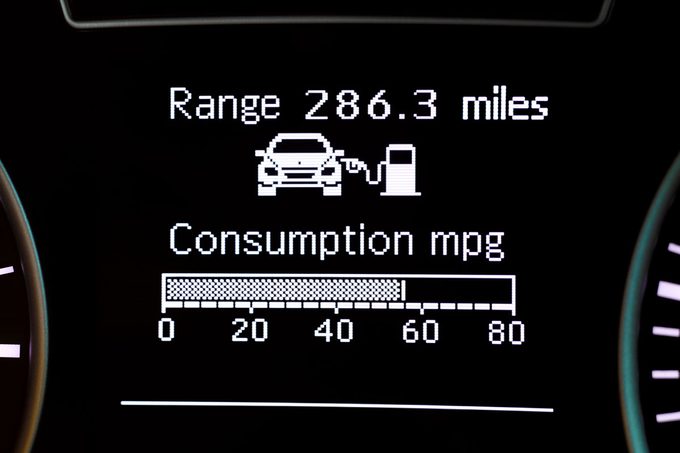Your car's in-dash fuel range estimates you have 50 miles left, should you believe it?

How Accurate Is Your Car’s Fuel Range Estimate?

Back in the day, you quickly learned how far you could drive once the fuel gauge hit “E” for empty. My car was seven miles, give or take. Today’s cars have an in-dash fuel range estimator which provides a data-driven guesstimate on how many miles you can possibly drive on one tank of gas. Read along as an automotive expert and mathematician helps explain what you need to know about your car’s fuel range estimator.
What Is a Fuel Range Estimate?
The fuel range estimate approximates the distance your car may travel before running out of gas. Although helpful, these estimates are more of a guide, not 100 percent accurate and are constantly being adjusted based on how you drive as well as other factors.
According to Gary Hindenes, owner of Gary’s Automotive Repair, “The factory estimate you have is accurate based on the data the car has. When you buy a car, you buy a car that says you get a certain amount of miles per gallon; however, your driving habits, maintenance, and geography will dictate how accurate your gas estimate is.”
How Is the Fuel Range Estimate Calculated?
Your car calculates its fuel range estimate using a combination of live data and past driving habits. These are some of the data and values being monitored and measured to help calculate the remaining fuel range/mileage.
- The fuel level sensor measures how much fuel is left in the tank.
- Fuel consumption is based on past data, such as fuel used during different driving conditions.
- Driving habits and behaviors, including car speed, braking, acceleration, and sitting at a red light or stop sign.
- Driving and weather conditions, including temperatures, going up a hill (measured using inclination sensors), and stop-and-go traffic, all influence fuel efficiency.
- Proprietary algorithms analyze data from multiple sensors and engine performance to provide an estimate of how far you can drive before running out of fuel.
- “Machine learning algorithms,” said math and science teacher, Greg Feliz, “help improve accuracy by tracking thousands of readings over several days to predict real-time conditions.”
How Accurate Is the Fuel Range Estimate?
According to AAA, don’t put all your trust in the in-dash fuel range estimate. AAA found a “relatively low error of 2.3% compared to the fuel economy measured by in-lab testing.” However, individual vehicles reacted differently to changes in driving, and the accuracy was affected by driving patterns and conditions. Added Hindenes, “If you’ve been driving conservatively on the highway, it’ll estimate a high number. But if at any moment you encounter traffic or begin driving aggressively, it’ll quickly plummet. Useful to a certain extent, but don’t rely on it to the exact mile — always leave some margin.”
FAQ
How does your car measure the mileage you’ve driven?
Newer cars use digital odometers that utilize sensors that track and count wheel rotations and then send and store the data to the car’s onboard computer. In contrast, some vehicles use GPS data, which calculates straight-line travel, while odometers measure total distance traveled, including stops and turns.
How can I check my odometer for accuracy?
Perform a “measured mile” test. On a clear, flat highway, when and where it’s safe and no other vehicles in the vicinity:
- Note a mile marker.
- Drive at 60 MPH.
- It should take exactly one minute to travel one mile at 60 MPH to the next mile marker.
Remember, the type of tires, tire size and pressure, and engine performance can affect this test process.
Take your car to the pros if there are any concerns.
Experts
- Gary Hindenes, owner of Gary’s Automotive Repair, an auto repair shop in Chandler, Arizona. He has been working on cars for over 30 years.
- Greg Feliz, M.S., as a systems engineering has over 15 years in industry, and an additional 20 years in the classroom as a Pennsylvania Department of Education certified K-12 chemistry, science and mathematics teacher and is currently teaching at Lansdale Catholic High School located in Lansdale, PA.
Resources
- AAA Newsroom: “Accuracy of In-Dash Fuel Economy Displays Full Research Report” (Jul 2021)
- AAA Newsroom: “Miles-to-Empty” Warning Fuels When Drivers Decide to Fill Up” (Jul 2021)
- Forbes: “Are In-Dash Fuel Economy Displays Accurate?” (July 2021)
- The National Center for Sustainable Transportation (NCST): “Vehicle Miles Traveled (VMT) Measurement Methods and Pilot Test for Collecting Odometer Readings” (Mar 2025)
- U.S. Department of Energy: “Find and Compare Cars Fuel Information” (May 13, 2025)




















